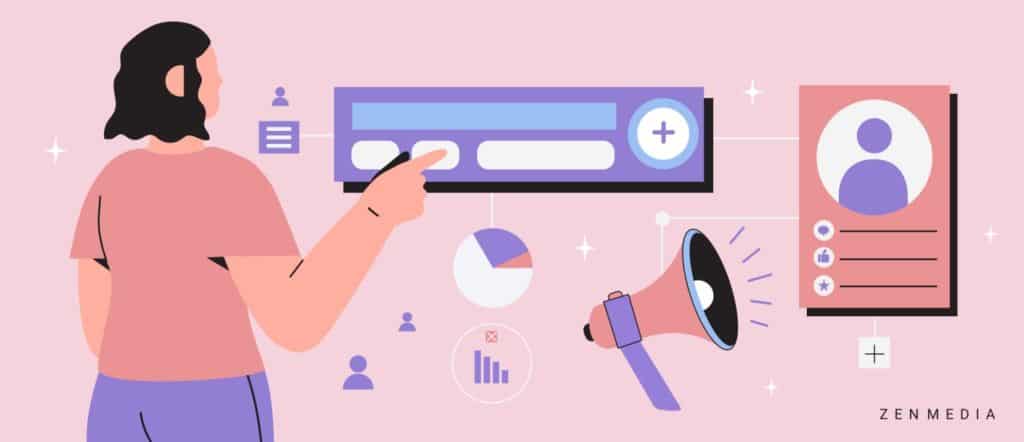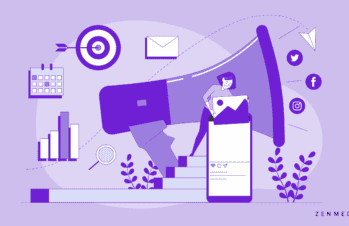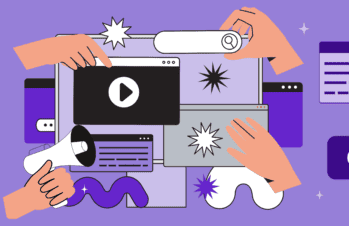You probably don’t realize it, but programmatic advertising is most likely a part of your daily media consumption. Think about your previously watched YouTube videos and podcasts or the social platforms you frequent that just so happen to advertise the products you were searching for a few days ago.
Why does this happen, and how are these ads so scary accurate? It’s because this kind of advertising uses AI technology to directly show you products and services you like.
It’s very unfortunate when your marketing team creates a stellar ad, but it falls flat because there wasn’t enough engagement or the ad was placed in front of the wrong crowd.
For marketers with a clear target audience, programmatic ads can guarantee your advertisements are in the right place at the right time for the right people.
The number of modern marketers implementing programmatic advertising into their digital strategies has increased to reach newer, more niche communities. Due to their efficiency and cost savings, programmatic ads have given marketers a significant advantage in this competitive landscape. As a result, it is rapidly becoming one of the most effective marketing tools for business leaders as digital marketing continues its upward rise and maintains its position as the primary way to communicate with prospects. According to research, the global programmatic ad spend reached an estimated $418.4 billion in 2021, surpassing $493 billion by 2022.
The United States remains the biggest spender on programmatic ads, with estimated spending of $167 billion in 2021. Still, other countries like the UK and China are catching up fast as more marketers begin to embrace the benefits programmatic advertising has to offer.
But even though programmatic advertising is reshaping the face of online advertising, many still don’t understand what it is. Here’s where we can help.
The Basics Of Programmatic Advertising
You can think of the entire process as a stock market trading floor for digital display advertising. Programmatic advertising, also known as programmatic ad buying, is the automation of your digital ad buying process with artificial intelligence and real-time bidding (RTB) — a way of buying and selling paid ads through real-time auctions. Publishers sell digital ad space, and buyers enter bids to advertise their content. Real-time bidding allows your ads to be served based on your budget and relevance, displaying your ads to your target audience without going over your budget. This process takes mere seconds due to automated algorithms, with buyers able to find qualified space for their ads almost instantly.
To run a programmatic advertising campaign, the advertiser has to specify their target audience, budget, and goal of the digital campaign. Some goals include increasing traffic to your website, increasing brand awareness, creating demand or lead generation, or selling your products. There are plenty of programmatic advertising platforms, but the most common ones are AdRoll, Adobe Advertising Cloud, Google Ads, Facebook Ads, and LinkedIn ads. Once you feed all of the information about your brand, the algorithm will do the hard work.
Types of Programmatic Ads
There are five kinds of ads you can use for your programmatic advertising. To best optimize your campaign, you should know your options.
- Social Ads: Ads served on social platforms such as Facebook or LinkedIn. Social media collects user data to create personalized experiences. That data determines when and how your target audience will see the ads.
- Audio Ads: Ads served on audio platforms such as Spotify, Pandora, or Podcasts.
- Video Ads: Ads shown in videos either before the video begins, during the video, or at the end of the video. There are also in-display video ads that appear as recommended on video-sharing sites like YouTube.
- Display Ads: Visual ads placed in a website’s header, footer, or sidebar.
- Native Ads: Ads that follow the form of the content they’re shown in on the body of a website. While display ads are limited to three places, native ads can appear literally anywhere else.
Some marketers use a combination of two or more formats, but you can customize your game plan that best suits your audience.
Related post: The Next Big Thing: iPhone Ad Marketing
How Programmatic Ad Buying Can Benefit Your Marketing Strategy
Using the technology at our disposal to replace some of the more menial tasks in marketing allows marketers and sellers to create more sophisticated, customized campaigns. In addition, programmatic advertising promises to make the ad buying system more efficient and cheaper by removing humans from the process wherever applicable.
Related post: How Paid Advertising Can Help Your B2B Brand
Flexible budgeting options
While it sounds expensive, programmatic advertising is very budget-friendly and an appropriate form of advertising for enterprises and small businesses alike. Businesses with limited budgets can put a monetary ceiling on programmatic ads, so they don’t overspend. This means your ads will never cost more than your maximum price—companies can simply up or reduce the budget whenever appropriate. As a result, brands can promote their products and services to their target audience.
Efficiency
Access to information in real-time allows marketers to make necessary changes without working on outdated information or paying for ads based solely on historical trends. Real-time data also gives marketers more transparency, so they have complete visibility on what sites their ads are being used on, what kinds of audiences are seeing their ads, and what they are getting in return on their investment. And since it’s automated, programmatic advertising can automatically track your results, so you don’t have to spend hours manually entering data to track your ad’s success.
Detailed Audience Targeting
Programmatic advertising allows for a level of targeting unparalleled by any other form of modern marketing. You can select specific features you want to target, including:
- Age
- Location
- Gender
- Purchase history
- Job title
With your parameters set, programmatic advertising simultaneously promotes your brand on multiple platforms with little effort on your part.
The future is bright for programmatic advertising in modern marketing tactics. Digital ads are the primary channel through which marketers broadcast their ad messaging to consumers. A good programmatic advertising platform will help you maximize sales, make data-driven decisions, and increase ad revenue.





